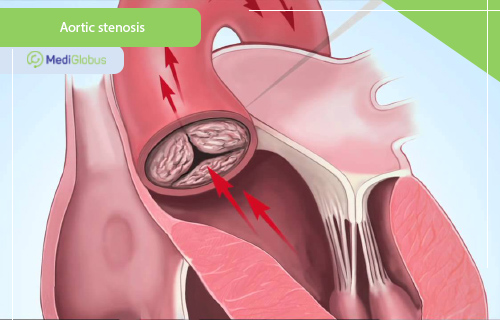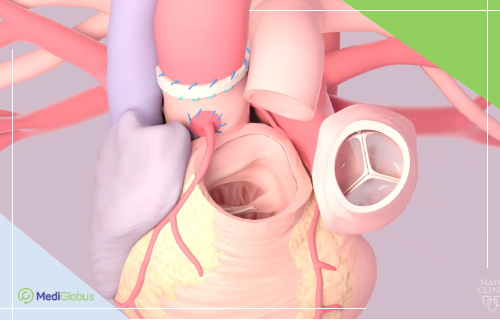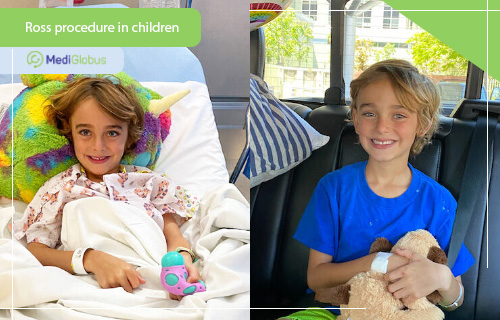The Ross procedure is used to correct congenital and acquired malformations of the aortic valve of the heart. It is most commonly used to treat children. The prognosis for survival after Ross surgery is very close to that of a healthy person and higher than that after an artificial valve installation. Read more about this procedure in our article.
What is Ross procedure and what are its indications?
Ross procedure is an open surgical intervention that is used to treat severe aortic valve defects. It involves transplanting the patient’s pulmonary valve in place of the defective aortic valve. A new pulmonary valve is created either from the patient’s tissues or from an external donor.
The Ross heart procedure is used to treat the following diagnoses:
Congenital aortic stenosis in children;
Endocarditis of the aortic heart valve;
Failure to repair the aortic valve in severe forms of heart disease;
Some forms of obstructive left ventricular outflow tract disease;
Some forms of aortic regurgitation with dilated aorta;
Bicuspid aortic valve with a small aortic ring.
Ross procedure is often prescribed to children as it improves their condition significantly. Infants with aortic stenosis suffer from chest pain, fatigue and abnormal breathing. They often have difficulty eating normally and may be stunted in growth and development because of the disease. Surgery can normalise the flow of blood to the heart and, as a consequence, benefit the whole body.
For small children, an artificial heart valve is not the best option. Firstly, medical companies do not make valves for babies; and secondly, because of the body’s rapid growth, it would require frequent reoperation and the fitting of increasingly larger valves.
Also, unlike the implantation of an artificial valve, Ross surgery has little effect on the patient’s lifestyle after the recovery period. Most patients are allowed to exercise and play sports.

Ross procedure is a technically complex surgery. Such interventions are not performed in every hospital, but only in technologically trained and experienced cardiac centres. For best results, an entire medical team including a cardiologist, cardiac surgeon, paediatric anaesthetist, cardiac nurse and cardiac pharmacologist are responsible for treating the child. Contact the international medical tourism platform MediGlobus for a free consultation and we will help you find the right clinic and book your treatment.
Services of the Mediglobus platform include: search and selection of clinics based on comparison according to patient’s criteria of interest, obtaining a prompt reply from clinics, translation of documents, arrangement of flight and accommodation, transfer to clinics, interpreter accompaniment, and visa support if required.
Ross procedure: pros and cons
Ross surgery is the only surgical procedure that allows you to replace a diseased aortic valve with a live one.
| Pros | Cons |
|---|---|
| No need to take anticoagulants for the rest of your life, as with an artificial valve. | After 15-20 years, most patients develop valve regurgitation or stenosis, requiring reoperation. |
| The risk of thrombosis is low. | It is a complex open surgery, with all the associated risks. |
| It is the only surgery that has a life expectancy similar to that of the average population. | The patient will need to remain under the care of a cardiologist and undergo regular check-ups to monitor the valve. |
| Quality of life is at a level as close as possible to that of a healthy person. | |
| Good haemodynamic values both at rest and during exercise. | |
| The valve grows with the baby. | |
| Women can conceive, bear and deliver children without any further risk to their health. | |
| Rapid improvement in well-being. |
How is the Ross procedure carried out?
Several diagnostic procedures are always prescribed before Ross surgery is performed. These are necessary to make sure that the patient is not contraindicated for the procedure and to obtain all the information the surgeon needs in preparation for the intervention. Diagnostics usually include:
A chest X-ray;
Electrocardiogram;
Echocardiography;
Cardiac catheterisation;
Blood tests.
The Ross procedure is performed under full anaesthesia and takes about 8-12 hours. During this time, the patient will be on a heart-lung machine. This makes it possible for surgeons to stop the heart and perform the necessary valve manipulations.
To gain access to the heart, the surgeon makes a vertical incision along the chest and performs a sternotomy – removing the bones in the chest. They then check the pulmonary valve to make sure it is healthy enough to replace the aortic valve.

The next step is to dissect the pulmonary artery and cut out the pulmonary valve. The latter is measured and prepared for transplantation to replace the aortic valve. To keep it as healthy as possible, it may be temporarily frozen. A lung graft is also prepared and implanted in place of the removed valve. Immediately after this step, the right and left coronary arteries are reconnected, which will ensure normal blood flow.
The cryopreserved pulmonary valve, which will become the new arterial valve, is then trimmed if necessary and implanted into the root of the lung. After disconnecting from the heart-lung machine, a transesophageal echocardiography is performed to assess valve function.
In the final stage, the surgeons put the sternum back in place and secure it with a wire. Sutures and a surgical dressing are applied to the area of the intervention.
After Ross surgery, the patient will usually need to stay in the hospital for 2-3 weeks. Before discharge, a repeat echocardiogram is done to check that the aortic and pulmonary valves are functioning normally. For the first month and a half, they will need to see a cardiologist and have control echocardiograms.
Consult a cardiologist
Find out if Ross surgery is right for your child by consulting an experienced cardiologist. Please submit a request online, along with your test results.
Contraindications to Ross procedure

There are some contraindications for Ross procedure. These include:
Diseases of the heart’s pulmonary valve that would make it unsuitable for transplantation;
Severe mitral valve disease;
Progressive tricuspid coronary artery disease;
Autoimmune diseases;
Marfan syndrome.
Some conditions are considered relative contraindications. This means that patients with these diagnoses have a higher risk of an adverse outcome, and surgeons need to carefully weigh up the potential risks and benefits of surgery. These include, in particular, rheumatic valve disease and dysplastic aortic root dilatation.
Safety and efficiency of the surgery
Over the years, surgeons have been able to refine the Ross procedure, and today it shows excellent results in terms of efficiency and safety in the hands of an experienced practitioner.
The majority of patients survive the Ross operation successfully. The 1-year survival rate is 97,8%, the 10-year survival rate is 94,2%, and the 20-year survival rate is 81,3%. Compared with the implantation of an artificial valve, this surgery shows a lower mortality rate as well as lower risks of bleeding, thromboembolism and endocarditis.
In 95-97% of people, the operation proceeds without any complications. In cases where they do develop, these can be:
Arrhythmias;
Infections;
Haemorrhages;
Aortic insufficiency;
Right ventricular outlet obstruction;
Aortic autograft dilatation;
Pulmonary allograft stenosis;
Cerebrovascular complications;
Myocardial infarction/ischaemia;
Respiratory distress;
Reactions to medication or anaesthesia.
In most patients, the new valves will last 15-20 years. After this time, calcification of the valves occurs, which necessitates a second operation. However, the good news is that a second procedure can be performed without opening the chest, but via a percutaneous puncture (catheter).
Patient feedback on Ross surgery
Grant is a normal American boy who at the age of eight was diagnosed with a bicuspid aortic valve with regurgitation and moderate/severe dilation. His parents were very frightened and began diligently seeking information about the diagnosis and the treatment options available. Everything was heading towards the point where surgery was unavoidable.
The boy’s father managed to find an excellent paediatric cardiac surgeon in their home state and was able to see him. There was a small hope that the defect could be corrected by aortic valvuloplasty, but after examination, the doctor concluded that such an operation would not have the desired effect. The Ross procedure was carried out to great results.
The outcome of the procedure was impressive. The boy was discharged from the hospital after just 3 days without any complications. Two weeks after the operation, he was already able to go back to school, and soon he was back to a completely normal, active child’s way of life.

Where to go for Ross surgery?
Summary
Ross procedure is performed to treat defects of the aortic heart valve, such as stenosis, endocarditis, regurgitation, etc. The procedure is most commonly indicated in children, but can also be performed on adult patients. It consists of replacing the aortic valve with the patient’s pulmonary valve.
The Ross procedure has the best survival rate of all available alternatives (over 97%), does not require a lifetime of anticoagulants and allows patients to lead an active life.
The main disadvantage of Ross surgery is the need for a second surgery after 15-20 years. Today, a repeat procedure is performed minimally invasively (through a catheter).
We recommend clinics in Turkey (Medistate, Liv), Spain (Quironsalud), Israel (Schneider), Germany (Cologne University Hospital), and Poland (AHOP).
To book your heart treatment abroad, click on the button below and fill in the form. Our coordinators will call you back within 30 minutes. They will provide you with all the necessary information and help with travel arrangements.
Sources:
- 1. Kristen N. Brown; Arun Kanmanthareddy: Aortic Valve Ross Operation
- 2. Annals of Cardiothoracic Surgery: Long-term outcomes of the Ross procedure in adults





